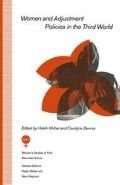Abstract
The chapters in this book have concentrated on the explicit adjustment policies initiated by governments in response to the international financial restrictions imposed largely by western donors, or credit agencies. But it is important to note that both in these explicit terms and elsewhere there is a central ideological theme at work which helps render women’s work invisible and class them as unemployed, and obligated to perform domestic services.1 The contention of this chapter is that such ideological constraints can, and do, impose limitations on women’s work which may be as restricting, if not more so, than economic ones. Female employment in Iran is a clear example, where despite a decade of war, massive carnage of young men and general call-up of all males over the age of twelve, there has been no rise in female employment and both in absolute and relative terms fewer women are participating in the labour market now than were fifteen years ago. This is all the more surprising since a stated policy of gender segregation at all levels should, at least in theory, have resulted in doubling employment opportunities for women working in the public and private sectors.2 Furthermore, contrary to the Third World trend, delineated in the previous chapters of this book, both the health and education sectors have been expanding their total employment and their proportion of female employment.
Access this chapter
Tax calculation will be finalised at checkout
Purchases are for personal use only
Preview
Unable to display preview. Download preview PDF.
Notes and References
For further discussion, see Val Moghadam, ‘Women, Work and Ideology in the Islamic Republic of Iran’, International Journal of Middle East Studies (May 1988) pp. 221–43; and Nimeyeh Digar, no. 10 (Winter) 1368 pp. 16–51; and Haleh Afshar, ‘Women in the Work and Poverty Trap in Iran’, in H. Afshar and B. Agarwal (eds), Women, Poverty and Ideology (Macmillan, 1989) pp. 17–42.
For further discussion, see H. Afshar, ‘Women, Marriage and the State in Iran’, in H. Afshar (ed.), Women State and Ideology (Macmillan, 1987) pp. 70–86; and ‘Behind the Veil: The Public and Private Faces of Khomeini’s Policies on Iranian Women’, in B. Agarwal (ed.), Structures of Patriarchy (Kali for Women and Zed Books, 1988) pp. 228–47; and ‘Women and Reproduction in Iran’, in N. Yuval-Davis and F. Anthias (eds), Women-Nation-State (Macmillan Press, 1989) pp. 110–25. Also A. Tabari and Yeganeh, In the Shadow of Islam (Zed Press);
Guity Neshat, ‘Women in the Ideology of the Islamic Republic’, in G. Neshat (ed.), Women and Revolution in Iran (Boulder, 1983), among many more.
For further discussion, see Haleh Afshar, ‘Epilogue’, in H. Afshar (ed.), Iran, A Revolution in Turmoil (Macmillan, 1989) pp. 244–53; and ‘Khomeini’s Teachings and Their Implications for Iranian Women’, in N. Yeganeh In the Shadow of Islam (Zed, 1982); as well as Val Moghadam, ‘The Reproduction of Gender Inequality’, World Development, and Sanar Qahraman, ‘Siyasateh hokoumateh Eslami piramouneh das-ressi zanan beh amouzesheh ali va asarateh an bar moqiyateh ejtemayi va eqtessadi zanan’ (The Islamic Republic’s policies on women’s access to higher education and its impact on the socio-economic position of women), Nimeyeh Digar, no. 7 (Summer) 1367 (1989).
For further discussion on the perception of the role of women in the labour market as a whole and as secretaries in particular, see Haleh Afshar, ‘Women, State and Ideology in Iran’, Third World Quarterly, vol. 7, no. 2 (April 1985) pp. 256–78.
For further discussion, see, for example, Nadia Hejab, Womanpower (Cambridge University Press, 1988).
For further discussion, see Haleh Afshar, Iran, Revolution in Turmoil (Macmillan, 1989).
For further discussion, see Haleh Afshar, ‘Women in the Work and Poverty Trap in Iran’, in Haleh Afshar and Bina Agarwal (eds), Women, Poverty and Ideology in Asia (Macmillan, 1989) pp. 18–42.
Editor information
Editors and Affiliations
Copyright information
© 1992 Haleh Afshar and Carolyne Dennis
About this chapter
Cite this chapter
Afshar, H. (1992). Women and Work: Ideology Not Adjustment at Work in Iran. In: Afshar, H., Dennis, C. (eds) Women and Adjustment Policies in the Third World. Women’s Studies at York/Macmillan Series. Palgrave Macmillan, London. https://doi.org/10.1007/978-1-349-11961-5_9
Download citation
DOI: https://doi.org/10.1007/978-1-349-11961-5_9
Publisher Name: Palgrave Macmillan, London
Print ISBN: 978-1-349-11963-9
Online ISBN: 978-1-349-11961-5
eBook Packages: Palgrave Social & Cultural Studies CollectionSocial Sciences (R0)

